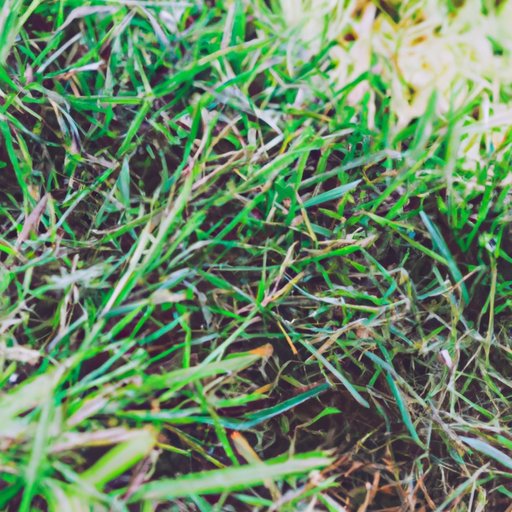Introduction
Crabgrass is a problematic weed that can invade your lawn, garden beds and even the cracks on your sidewalk. Initially, the presence of this grassy weed may appear harmless, but it can quickly take over your entire yard if left unchecked. The broad leaves and sprawling growth pattern of crabgrass make it look unsightly and can quickly become a nuisance. For this reason, it is essential to take measures to control or eliminate its growth. In this article, we will explore different methods to get rid of crabgrass effectively.
Identifying Crabgrass
Before considering how to eliminate crabgrass, it is necessary to identify it correctly. Crabgrass has wide leaves that curl near the base of the blade, and it grows in a flat pattern similar to a crab’s legs, hence the name “crabgrass.” Sometimes, crabgrass can be confused with other types of common grasses, such as Bermuda or St. Augustine. To differentiate, look for the distinctive seed heads found at the tips of crabgrass stems.
Prevention Tactics
The best way to get rid of crabgrass is, to begin with, prevention tactics before it takes root. Proper lawn maintenance is essential to discourage crabgrass growth. Start by mowing your lawn at the highest recommended height for your grass type. A well-established lawn can withstand crabgrass growth better. Additionally, water your lawn deeply but infrequently, allowing the grass roots to grow deeper. This reduces the opportunity for crabgrass seed to germinate.
Another useful approach is to fertilize your lawn regularly. Choose a fertilizer designed to strengthen your particular grass type and follow recommended application instructions. This helps the grass grow thicker and stronger, making it more challenging for crabgrass to invade.
Pre-emergent herbicides can also prevent crabgrass growth. They work by creating a barrier on the soil’s surface, preventing the emergence of crabgrass seed. Apply this herbicide in the early spring after your final frost and before the soil temperature reaches 60°F. This way, you ensure there is enough time for the herbicide to take effect before crabgrass seed germination.
Natural Remedies
Some household items can be used as natural remedies to suppress crabgrass growth. Vinegar, baking soda, and corn gluten meal are inexpensive and safe to use around your garden. Vinegar is a popular choice because of its high acidity level which dehydrates and kills the weed. To use vinegar as a herbicide, mix it with water and spray it on the weeds. Corn gluten meal acts as a pre-emergent herbicide that prevents weeds from developing. Baking soda is also useful to eliminate crabgrass as it alters the pH levels in the soil, making it difficult for crabgrass to grow.
When using a natural weed killer, be sure to follow the manufacturer’s guidelines carefully. Natural remedies may also need multiple applications, and their effects may not last as long as chemical herbicides.
Chemical Solutions
When natural remedies don’t cut it, chemical herbicides can be a more effective solution. These herbicides work fast to attack crabgrass and other unwanted grasses and weeds. They are available as either selective or non-selective herbicides. Selective herbicides target specific types of weeds, which leave desirable plants intact. Non-selective herbicides, on the other hand, kill anything in its path, even your desired plants. For this reason, be sure to read the label on the herbicide you choose carefully.
Safety is also crucial when using chemical herbicides. Wear protective gear, such as gloves, long-sleeved shirts, and pants. Avoid using herbicides on a windy day to prevent the product from drifting onto other areas of your lawn or into nearby water sources. Always follow the instructions on the label carefully for how to use the herbicide safely.
Manual Removal
For small patches of crabgrass weed, manual removal can be an effective option. Pull the weed out by its roots with hand or a weed puller tool. Be sure to pull the entire plant, including the roots. Ensure to discard the plant’s top and roots off the lawn and use a large trash can to avoid spreading the seeds to other parts of the lawn or garden. However, manual removal can be time-consuming and is not feasible for large lawns.
Over-seeding
Overseeding is an excellent option for aggressive crabgrass growth because it promotes the growth of new and healthy grasses, making it more difficult for crabgrass to grow. Opt for quality grass seed that thrives in your soil, growing environment and sunlight exposure. Early fall and late spring are the best time for overseeding. Before overseeding, ensure the lawn is free from dead grass, weeds, and debris, and the soil is levelled and loosened.
Professional Assistance
If all of the above options do not suffice, consider professional crabgrass control assistance. Professional services can help you create a personalized crabgrass prevention plan based on your lawn state and its challenges. They can also recommend the best herbicides, pre-emergent treatments, and crabgrass removal options. Before hiring a professional, ask for references from other customers, and be sure to check their rating on reputable sites.
Conclusion
Controlling crabgrass can be challenging, but it is achievable with the right methods. Prevention tactics such as regular lawn maintenance, fertilization, and pre-emergent herbicide application can limit crabgrass growth. Chemical and natural remedies manage crabgrass that has already appeared. Manual removal works for small patches, while overseeding can promote the growth of healthy grasses. Finally, professional assistance can be a helpful solution for complex crabgrass issues. By utilizing these methods, you can create a weed-free, healthy lawn.
